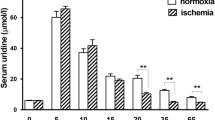Summary
In dog myocardium, the changes in the levels of creatine phosphate, inorganic phosphate, ATP, ADP, AMP, adenosine and inosine with 8 min of ischemia and subsequent reperfusion for 2, 4, 8, 16 and 32 min have been followed. Creatine phosphate and inorganic phosphate recovered completely within a few minutes as did the energy charge. However, total nucleotides remained depressed, the decrease being compensated for by the increase in inosine levels during ischemia. There was a rapid removal of the latter with reperfusion. Low oral doses of mioflazine (2.5 mg·kg−1), given 2.5 h before LAD occlusion, did not affect the pattern of changes seen in control animals, except for the nucleosides. The drug induced a complete reversal of the adenosine to inosine ratio during ischemia and a remarkable prolongation of the accumulation within the tissue of mainly adenosine during early reperfusion and inosine afterwards. Assuming that the main action of mioflazine is through inhibition of nucleoside transport, the present results provide interesting information about the mechanism of release, metabolism and final washout of adenosine.
Similar content being viewed by others
References
Allison TB, Holsinger JW (1983) Myocardial metabolism and regional myocardial blood flow in the canine left ventricle following twenty minutes of circumflex artery occlusion and reperfusion. J Mol Cell Cardiol 15:151–161
Degenring FH, Curnish RR, Rubio R, Berne RM (1976) Effect of dipyridamole on myocardial adenosine metabolism and coronary flow in hypoxia and reactive hyperemia in the isolated perfused guinea pig heart. J Mol Cell Cardiol 8:877–888
Flameng W, Xhonneux R, Van Belle H, Borgers M, Van de Water A, Wynants J, Wouters L, Thoné F, Van Daele P, Janssen PAJ (1984). Cardioprotective effects of mioflazine during one hour of normothermic global ischemia in the canine heart. Cardiovasc Res 18:528–537
Foker JE, Einzig S, Wong T (1980) Adenosine metabolism and myocardial preservation. J Thorac Cardiovasc Surg 80:506–516
Gordon JL (1986) Extracellular ATP: effects, sources and fate. Biochem J 233:309–319
Jennings RB, Schaper J, Hill ML, Steenbergen C, Reimer KA (1985) Effect of reperfusion late in the phase of reversible ischemic injury. Circ Res 56:262–278
Knabb RM, Gidday JM, Ely SW, Rubio R, Berne RM (1984) Effects of dipyridamole on myocardial adenosine and active hyperemia. Am J Physiol 247:H804-H810
Lange R, Ingwall J, Hale SL, Alker KJ, Braunwald E, Kloner RA (1984) Preservation of highenergy phosphates by verapamil in reperfused myocardium. Circulation 70:734–741
Lange R, Ware J, Kloner RA (1984) Absence of a cumulative deterioration of regional function during three repeated 5 or 15 minute coronary occlusions. Circulation 69:400–408
Nees S, Gerlach E (1983) Adenine nucleotide and adenosine metabolism in cultured coronary endothelial cells: formation and release of adenine compounds and possible functional implications. In: Berne RM, Rall TW, Rubio R (eds) Regulatory Function of Adenosine. Martinus Nijhoff, Boston, pp 347–360
Reimer KA, Hill ML, Jennings RB (1981) Prolonged depletion of ATP and of the adenine nucleotide pool due to delayed resynthesis of adenine nucleotides following reversible myocardial ischemic injury in dogs. J Mol Cell Cardiol 13:229–239
Sparks HV Jr, Dewitt DF, Wangler RD, Gorman MW, Bassingthwaighte JB (1985) Capillary transport of adenosine. Fed Proc 44:2620–2622
Swain JL, Sabina RL, McHale PA, Greenfield JC, Holmes EW (1982) Prolonged myocardial nucleotide depletion after brief ischemia in the open-chest dog. Am J Physiol 242:H818-H826
Van Belle H (1986) Myocardial purines during ischemia, reperfusion and pharmacological protection. Mol Physiol, in press
Van Belle H, Wynants J, Xhonneux R, Flameng W (1986) Changes in creatine phosphate, inorganic phosphate and the purine pattern in dog hearts with time of LAD occlusion and effect thereupon of mioflazine, a nucleoside transport inhibitor. Cardiovasc Res, in press
Author information
Authors and Affiliations
Rights and permissions
About this article
Cite this article
Van Belle, H., Xhonneux, R., Flameng, W. et al. Oral pretreatment with mioflazine completely changes the pattern and remarkably prolongs the accumulation of nucleosides in ischemic and reperfused myocardium. Basic Res Cardiol 81, 407–416 (1986). https://doi.org/10.1007/BF01907461
Received:
Issue Date:
DOI: https://doi.org/10.1007/BF01907461



